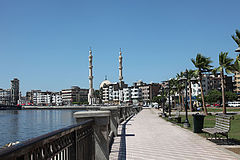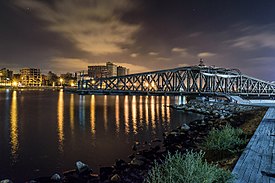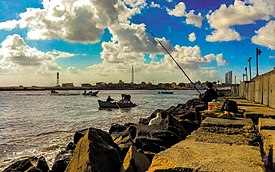Damietta
Damietta
| |
|---|---|
(From top left) the Old Bridge, Maeini Mosque entrance, Damietta Corniche, Maeini Mosque dome, fishing in Damietta. | |
|
UTC+2 (EST) | |
| Area code | (+20) 57 |



Damietta (
Etymology
History
Mentioned by the 6th-century geographer
Under
Damietta was again important in the 12th and 13th centuries during the time of the
During preparations for the Fifth Crusade in 1217, it was decided that Damietta should be the focus of attack. Control of Damietta meant control of the Nile, and from there the crusaders believed they would be able to conquer Egypt. From Egypt they could then attack Palestine and recapture Jerusalem. After the siege of Damietta of 1218–1219, the port was occupied by the Crusaders. The siege devastated the population of Damietta. After the crusaders captured Damietta in November 1219 they looted the city.[9] Earlier that year, Francis of Assisi had arrived to peaceably negotiate with the Muslim ruler.[10][11] In 1221 the Crusaders attempted to march to Cairo, but were destroyed by the combination of nature and Muslim defenses.[12]
Damietta was also the object of the Seventh Crusade, led by Louis IX of France. His fleet arrived there in 1249 and quickly captured the fort, which he refused to hand over to the nominal king of Jerusalem, to whom it had been promised during the Fifth Crusade.[13] However, having been taken prisoner with his army in April 1250, Louis was obliged to surrender Damietta as ransom.[4]
Hearing that Louis was preparing a new crusade, the
Ecclesiastical history
Hellenistic Tamiathis became a Christian
In 1249, when Louis IX of France captured the city, it became for a short time the seat of a Latin Church bishop.[17]
The Latin bishopric, no longer residential, is today listed by the
Titular Latin see
The diocese was nominally restored in the 17th century when established as Latin
- Bernardino Spada (later Cardinal) (1623.12.04 – 1626.01.19)
- Cardinal Cesare Facchinetti (1639.09.05 – 1672.11.14)
- Neri Corsini (later Cardinal) (1652.08.12 – 1664.01.14)
- Angelo Maria Ranuzzi (later Cardinal) (1668.04.30 – 1678.04.18)
- Ercole Visconti (1678.07.18 – ?)
- Marco Antonio Ansidei (later Cardinal) (1724.06.12 – 1726.12.16)
- Raffaele Cosimo De Girolami (later Cardinal) (1728.03.08 – 1743.09.09)
- Paul Alpheran de Bussan, Sovereign Military Order of Malta(O.B.E.) (1746.09.19 – 1757.04.20)
- Vincenzo Maria de Francisco e Galletti, Dominican Order (O.P.) (1757.12.19 – 1769.07.19)
- Bonaventura Prestandrea, Conventual Franciscans(O.F.M. Conv.) (1769.12.18 – 1777.12.21)
- Bartolomeo Pacca (later Cardinal) (1785.09.26 – 1801.02.23)
- Giovanni Francesco Compagnoni Marefoschi (1816.04.29 – 1820.09.17)
- Giovanni Giacomo Sinibaldi (1821.08.13 – 1843.01.27) (later Patriarch)*
- Vincenzo Gioacchino Pecci (later Pope Leo XIII) (1843.01.27 – 1846.01.19)
- Diego Planeta (1850.01.07 – 1858.06.05)
- Luigi Oreglia di Santo Stefano (later Cardinal) (1866.05.04 – 1873.12.22)
- Eugène-Louis-Marie Lion, O.P. (1874.03.13 – 1883.08.08)
- Eugenio Lachat, Missionaries of the Precious Blood (C.PP.S.) (1885.03.23 – 1886.11.01)
- Ignazio Persico (德斯馬曾), O.F.M. Cap. (later Cardinal) (1887.03.14 – 1893.01.16)
- Andrea Aiuti (later Cardinal) (1893.06.12 – 1903.06.22)
- Edoardo Carlo Gastone Pöttickh de Pettenegg, Teutonic Order (O.T.) (1904.11.14 – 1918.10.01)
- Sebastião Leite de Vasconcellos (1919.12.15 – 1923.01.29)
- Luigi Pellizzo (1923.03.24 – 1936.08.14)
Demoted in 1925 as Titular bishopric, it has been vacant for decades, having had the following incumbents, all of the episcopal (lowest) rank:
- Guglielmo Grassi (1937.01.13 – 1954.09.14)
- Eugenio Beitia Aldazabal (1954.10.30 – 1962.01.27)
- Marco Caliaro, Scalabrinians (C.S.) (1962.02.10 – 1962.05.23)
- Antonio Cece (1962.08.06 – 1966.03.31)
Titular Melkite see
Established in 1900 as
- Titular Bishop Paul-Raphaël Abi-Mourad (1900.07.02 – 1935.08.08)
Restored in 1961 as Titular archbishopric, it has had the following incumbents of the archiepiscopal (intermediary) rank:
- Titular Archbishop Antonio Farage (1961.03.07 – 1963.11.09)
- Titular Archbishop Nicolas Hajj (1965.07.30 – 1984.11.03)
- Titular Archbishop Joseph Jules Zerey (2001.06.22 – ... ), Jerusalem of the Greek-Melkites(Palestine)
Climate
are also common. .| Climate data for Damietta, Egypt | |||||||||||||
|---|---|---|---|---|---|---|---|---|---|---|---|---|---|
| Month | Jan | Feb | Mar | Apr | May | Jun | Jul | Aug | Sep | Oct | Nov | Dec | Year |
| Mean daily maximum °C (°F) | 17.2 (63.0) |
18.1 (64.6) |
19.9 (67.8) |
23.2 (73.8) |
27.3 (81.1) |
28.8 (83.8) |
29.9 (85.8) |
30.3 (86.5) |
28.9 (84.0) |
27.3 (81.1) |
23.8 (74.8) |
19.2 (66.6) |
24.5 (76.1) |
| Daily mean °C (°F) | 13.2 (55.8) |
13.8 (56.8) |
15.4 (59.7) |
18.4 (65.1) |
22.2 (72.0) |
24.2 (75.6) |
25.9 (78.6) |
26.3 (79.3) |
24.8 (76.6) |
23.3 (73.9) |
19.8 (67.6) |
15.2 (59.4) |
20.2 (68.4) |
| Mean daily minimum °C (°F) | 9.2 (48.6) |
9.6 (49.3) |
11.0 (51.8) |
13.6 (56.5) |
17.1 (62.8) |
19.7 (67.5) |
22.0 (71.6) |
22.3 (72.1) |
20.7 (69.3) |
19.3 (66.7) |
15.8 (60.4) |
11.3 (52.3) |
16.0 (60.7) |
| Average precipitation mm (inches) | 26 (1.0) |
18 (0.7) |
13 (0.5) |
5 (0.2) |
2 (0.1) |
0 (0) |
0 (0) |
0 (0) |
0 (0) |
7 (0.3) |
15 (0.6) |
25 (1.0) |
111 (4.4) |
| Source: climate-data.org[19] | |||||||||||||
Economy
Damietta is very famous for its furniture industry. In addition to the Egyptian market, its furniture is sold in Arab countries, Africa, Europe, the United States, and almost all over the world. Today, there is a canal connecting it to the Nile, which has made it an important port once again. Containers are transported through the new Damietta Port. The Damietta governorate has a population of about 1,093,580 (2006). It contains the SEGAS LNG (Liquefied Natural Gas) plant,[20] which will ultimately have a capacity of 9.6 million ton/year through two trains. The plant is owned by Segas, a joint venture of the Spanish utility Unión Fenosa (40%), Italian oil company Eni (40%) and the Egyptian companies EGAS and EGPC (10% each).[21] The plant is unusual since it is not supplied from a dedicated field, but is supplied with gas from the Egyptian grid. As of 2010[update], EMethanex, the Egyptian division of Methanex Corporation, a Canadian owned company, was building a 3600 MTPD methanol plant. Damietta also has a woodworking industry and is also noted for its White Domiati cheese and other dairy products[22] and Pâtisserie and Egyptian desserts. It is also a fishing port.
Main sights
- Mosques
- Amr ibn al-As Mosque (Damietta), the second mosque to be built in Egypt and Africa by the Arabs after entering Egypt. It was twice converted to a church during the city's occupation by the Crusaders. Louis IX of France's son, John Tristan, was baptized by a legate of the pope in this mosque.
- Al-Bahr Mosque, dating to the Ottoman rule era.
- Al-Hadidy Mosque in Faraskour, 200 years old.
- Al-Maainy Mosque, dating to the reign of al-Naser Mohammed ibn Qalawon.
- Al-Matbuly Mosque, dating to the Mamluk era.
- Al-Radwaniya Mosque, dating to the Mamluk era.
- Other

- Tabiet Ahmed Urabi, ruins of Damietta Fort at Ezbet El-Borg.
- The Old Bridge (el-Kōbrī el-Qadīm), dating to the early 20th century.
- Souk al-Hesba, the old city centre, dating to the Abbasid rule era.
Notable people
- Kamal al-Din Muhammad ibn Musa Al-Damiri, (1344–1405), writer on canon law and natural history[23]
- Refaat Al-Gammal (Raafat el-Haggan), Egyptian spy
- Professor Aisha Abd al-Rahman (Bent Al Shatea), journalist and Muslim philosopher
- Latifa al-Zayyat, activist and writer
- Professor Abdel Rahman Badawi, professor of philosophy
- St. Sidhom Bishay, Coptic martyr
- Rifaat El-Fanagily, football player
- Mohamed Fahim ElGindy, who established and developed the furniture industry during 20th century in Damietta
- Rifaat el-Mahgoub, former Head of the Egyptian Parliament and a member of the ruling National Democratic Party
- Besheer El-Tabei, football player
- Mohammed Hassan El-Zayyat, former minister of foreign affairs.
- Al-Gama'a al-Islamiyyagroup.
- Zahi Hawass, Egyptologist
- Yusuf Idris, writer and psychiatrist
- Zaki Naguib Mahmoud, writer and philosopher
- Ali Moustafa Mosharafa, physicist and contributor to the theory of relativity
- Farouk Shousha, poet; previously head of Egyptian Radio (El Soaraa village)
- Essam El Hadary, football player
See also
- Damiaatjes
- Caphutkia ancient name of Damietta in Aramaic & Jewish literature.
- Sheremsah
- Caphtor
- Damietta toad
- Domiati
References
- ^ a b "Egypt: Governorates, Major Cities & Towns - Population Statistics, Maps, Charts, Weather and Web Information". citypopulation.de. Retrieved 13 June 2023.
- ^ "GDP BY GOVERNORATE", mped.gov.eg
- ^ Peust, Carsten (2010). Die Toponyme vorarabischen Ursprungs im modernen Ägypten. p. 38.
- ^ a b c d e Siméon Vailhé, "Damietta" in The Catholic Encyclopedia (New York 1908)
- ^ Smith, Sir William (1857). Dictionary of Greek and Roman geography. Little, Brown and Co. p. 1086. Retrieved 30 May 2012.
- ISBN 0-87169-248-1.
- ISBN 978-0-595-34946-3. Retrieved 30 May 2012.
- ISBN 978-1-4426-0060-7. Retrieved 30 May 2012.
- ISBN 978-0-85115-357-5.
- ISBN 978-0-85115-357-5. Retrieved 30 May 2012.
- ISBN 978-1-56548-112-1. Retrieved 30 May 2012.
- ISBN 978-1-57958-282-1. Retrieved 30 May 2012.
- ^ Russell, William (1837). The History of Modern Europe: with an Account of the Decline and Fall of the Roman Empire: And a View of the Progress of Society from the Rise of the Modern Kingdoms to the Peace of Paris, in 1763; in a Series of Letters from a Nobleman to His Son. Longman, Rees, & Company. p. 280. Retrieved 30 May 2012.
- ISBN 978-90-04-08265-6. Retrieved 30 May 2012.
- ^ Michel Lequien, Oriens christianus in quatuor Patriarchatus digestus, Paris 1740, Vol. II, coll. 589-592
- ^ Gaetano Moroni, Dizionario di erudizione storico ecclesiastica, Vol. 72 (Venice 1855), p. 236
- ^ MESSYNESSY (15 March 2019). "Paris or Egypt? 100 Years Ago, It Was Hard to Tell the Difference". Messy Nessy Cabinet of Chic Curiosities. Retrieved 22 February 2022.
- ISBN 978-88-209-9070-1), p. 879
- ^ "Climate: Dumiat - Climate graph, Temperature graph, Climate table". climate-data.org. Retrieved 13 August 2013.
- ^ MEED. Economic East Economic Digest, Limited. April 2008. p. 187. Retrieved 30 May 2012.
- ^ The Petroleum Economist. Petroleum Press Bureau. 2008. p. 20. Retrieved 30 May 2012.
- ^ "Halayeb". eArabic Market. Retrieved 17 December 2016.
- ^ "Islamic Medical Manuscripts: Bio-Bibliographies - B, C, and D". nih.gov.
External links
- GCatholic - Latin titular see with incumbent biography links
- GCatholic - Melkite titular see with incumbent biography links





